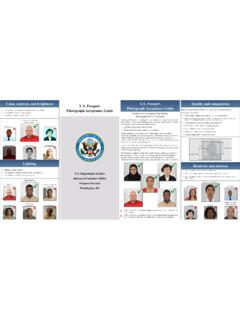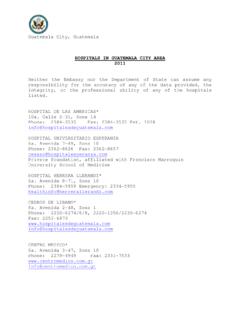Transcription of OUTLINE OF U.S. History - United States Department of State
1 Early SettlementColonial PeriodRoad to IndependenceForming a GovernmentWestward ExpansionSectional ConflictCivil War Economic Growth Discontent and ReformWar, Prosperity, and DepressionThe New Deal and World War IIPostwar ProsperityCivil Rights and Social ChangeA New World OrderBridge to the 21st Century2008 Presidential ElectionOUTLINE OF HISTORYOUTLINE OFOUTLINE OFBureau of International Information Department of State2011 CHAPTER 1 Early America ..4 CHAPTER 2 The Colonial Period ..22 CHAPTER 3 The Road to Independence ..50 CHAPTER 4 The Formation of a National Government ..66 CHAPTER 5 Westward Expansion and Regional Differences ..110 CHAPTER 6 Sectional Conflict ..128 CHAPTER 7 The Civil War and Reconstruction ..140 CHAPTER 8 Growth and Transformation ..154 CHAPTER 9 Discontent and Reform ..188 CHAPTER 10 War, Prosperity, and Depression ..202 CHAPTER 11 The New Deal and World War II ..212 CHAPTER 12 Postwar America.
2 256 CHAPTER 13 Decades of Change: 1960-1980 ..274 CHAPTER 14 The New Conservatism and a New World Order ..304 CHAPTER 15 Bridge to the 21st Century ..320 CHAPTER 16 Politics of Hope ..340 PICTURE PROFILES Becoming a Nation ..38 Transforming a Nation ..89 Monuments and Memorials ..161 Turmoil and Change ..229 21st Century Nation ..293 Bibliography ..346 Index .. HISTORYOUTLINE OFOUTLINE OF4 CHAPTEREARLY AMERICA1 Mesa Verde settlement in Colorado, 13th Heaven and Earth never agreed better to frame a place for man s habitation. Jamestown founder John Smith, 1607 THE FIRST AMERICANSAt the height of the Ice Age, be-tween 34,000 and 30,000 B .C ., much of the world s water was locked up in vast continental ice sheets . As a result, the Bering Sea was hundreds of meters below its current level, and a land bridge, known as Beringia, emerged between Asia and North America . At its peak, Beringia is thought to have been some 1,500 ki-lometers wide.
3 A moist and treeless tundra, it was covered with grasses and plant life, attracting the large animals that early humans hunted for their survival .The first people to reach North America almost certainly did so without knowing they had crossed into a new continent . They would have been following game, as their ancestors had for thousands of years, along the Siberian coast and then across the land bridge .Once in Alaska, it would take these first North Americans thou-sands of years more to work their way through the openings in great glaciers south to what is now the United States . Evidence of early life in North America continues to be found . Little of it, however, can be reliably dated before 12,000 B .C .; a recent discovery of a hunting look-out in northern Alaska, for exam-ple, may date from almost that time . So too may the finely crafted spear points and items found near Clovis, New Mexico.
4 Similar artifacts have been found at sites throughout North and South America, indicating that life was probably already well established in CHAPTER 1: EARLY AMERICAOUTLINE OF HISTORY7much of the Western Hemisphere by some time prior to 10,000 B .C .Around that time the mammoth began to die out and the bison took its place as a principal source of food and hides for these early North Americans . Over time, as more and more species of large game van-ished whether from overhunting or natural causes plants, berries, and seeds became an increasingly important part of the early Ameri-can diet . Gradually, foraging and the first attempts at primitive agri- culture appeared . Native Americans in what is now central Mexico led the way, cultivating corn , squash, and beans, perhaps as early as 8,000 B .C . Slowly, this knowledge spread northward .By 3,000 B .C ., a primitive type of corn was being grown in the river valleys of New Mexico and Arizo-na.
5 Then the first signs of irrigation began to appear, and, by 300 B .C ., signs of early village life .By the first centuries A .D ., the Hohokam were living in settlements near what is now Phoenix, Arizo-na, where they built ball courts and pyramid-like mounds reminiscent of those found in Mexico, as well as a canal and irrigation system .MOUND BUILDERS AND PUEBLOSThe first Native-American group to build mounds in what is now the United States often are called the Adenans . They began construct-ing earthen burial sites and forti-fications around 600 B .C . Some mounds from that era are in the shape of birds or serpents; they probably served religious purposes not yet fully understood .The Adenans appear to have been absorbed or displaced by vari-ous groups collectively known as Hopewellians . One of the most im-portant centers of their culture was found in southern Ohio, where the remains of several thousand of these mounds still can be seen.
6 Believed to be great traders, the Hopewel-lians used and exchanged tools and materials across a wide region of hundreds of kilometers .By around 500 A .D ., the Hopewellians disappeared, too, gradually giving way to a broad group of tribes generally known as the Mississippians or Temple Mound culture . One city, Ca-hokia, near Collinsville, Illinois, is thought to have had a population of about 20,000 at its peak in the early 12th century . At the center of the city stood a huge earthen mound, f lattened at the top, that was 30 meters high and 37 hectares at the base . Eighty other mounds have been found nearby .Cities such as Cahokia depend-ed on a combination of hunting, foraging, trading, and agriculture for their food and supplies . Inf lu-enced by the thriving societies to the south, they evolved into complex hi-erarchical societies that took slaves and practiced human sacrifice.
7 8In what is now the southwest United States , the Anasazi, ancestors of the modern Hopi Indians, began building stone and adobe pueblos around the year 900 . These unique and amazing apartment-like struc-tures were often built along cliff faces; the most famous, the cliff palace of Mesa Verde, Colorado, had more than 200 rooms . Another site, the Pueblo Bonito ruins along New Mexico s Chaco River, once contained more than 800 rooms .Perhaps the most aff luent of the pre-Columbian Native Americans lived in the Pacific Northwest, where the natural abundance of fish and raw materials made food supplies plentiful and permanent villages pos-sible as early as 1,000 B .C . The opu-lence of their potlatch gatherings remains a standard for extravagance and festivity probably unmatched in early American History .NATIVE-AMERICAN CULTURESThe America that greeted the first Europeans was, thus, far from an empty wilderness.
8 It is now thought that as many people lived in the Western Hemisphere as in West-ern Europe at that time about 40 million . Estimates of the number of Native Americans living in what is now the United States at the onset of European colonization range from two to 18 million, with most histori-ans tending toward the lower figure . What is certain is the devastating ef-fect that European disease had on the indigenous population practi-cally from the time of initial con-tact . Smallpox, in particular, ravaged whole communities and is thought to have been a much more direct cause of the precipitous decline in the Indian population in the 1600s than the numerous wars and skir-mishes with European settlers .Indian customs and culture at the time were extraordinarily diverse, as could be expected, given the ex-panse of the land and the many dif-ferent environments to which they had adapted.
9 Some generalizations, however, are possible . Most tribes, particularly in the wooded eastern region and the Midwest, combined aspects of hunting, gathering, and the cultivation of maize and other products for their food supplies . In many cases, the women were responsible for farming and the distribution of food, while the men hunted and participated in war .By all accounts, Native-American society in North America was closely tied to the land . Identification with nature and the elements was integral to religious beliefs . Their life was essentially clan-oriented and com-munal, with children allowed more freedom and tolerance than was the European custom of the day .Although some North Ameri-can tribes developed a type of hi-eroglyphics to preserve certain texts, Native-American culture was primarily oral, with a high value placed on the recounting of tales and dreams.
10 Clearly, there was a good deal of trade among various CHAPTER 1: EARLY AMERICAOUTLINE OF HISTORY9groups and strong evidence exists that neighboring tribes maintained extensive and formal relations both friendly and hostile .THE FIRST EUROPEANSThe first Europeans to arrive in North America at least the first for whom there is solid evidence were Norse, traveling west from Greenland, where Erik the Red had founded a settlement around the year 985 . In 1001 his son Leif is thought to have explored the north-east coast of what is now Canada and spent at least one winter there .While Norse sagas suggest that Viking sailors explored the Atlan-tic coast of North America down as far as the Bahamas, such claims remain unproven . In 1963, however, the ruins of some Norse houses dat-ing from that era were discovered at L Anse-aux-Meadows in northern Newfoundland, thus supporting at least some of the saga claims.









